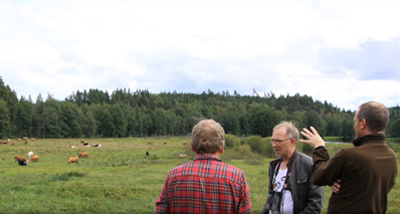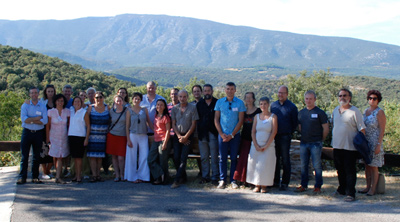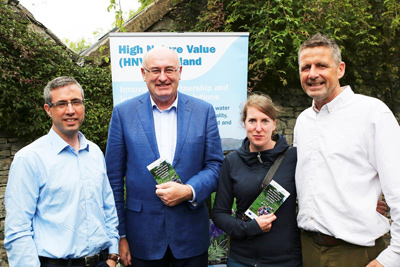HNV-Link Newsletter #1 (2016)
_cropped_NL_edited_edges.jpg)
HNV-Link project aims at identifying and sharing innovations that support farming systems in territories of exceptional natural values across Europe. It is funded under the European Union’s Horizon 2020 Programme.
The newsletter of HNV-Link will be published twice a year.
Content:
Greetings from the network coordinator Dr François Lerin
High Nature Value (HNV) farming systems are key components of European agricultural landscapes, and provide important ecosystem services at the continental scale. The existence and permanence of HNV farming systems is essential for natural and cultural heritage preservation, biodiversity conservation, and high quality agricultural production. However, these European farming systems are largely marginalised geographically, economically, socially, and politically. This isolation is reflected in research, development, and educational priorities.
During 2016-2019, the 13-partner strong consortium HNV-Link will focus on collecting, developing, transferring, and disseminating innovative solutions for supporting HNV farmland. To meet the aims of improving socio-economic viability and environmental efficiency of HNV farming areas, HNV-Link operates at both grassroots and transnational levels and connects territories composed of farmers, research and innovation actors.
Fusing modern research skills and tools with local innovations and motivations is vital in the quest for safeguarding the future of HNV farming areas across Europe. We are very proud of our network’s commitment to keep strong links between agriculture and environment, on the one hand, and analytical and practical focus, on the other.
Dr François Lerin,
Network coordinator from the International Centre for Advanced Mediterranean Agronomic Studies, Montpellier, France
Connecting knowledge and innovation within European HNV areas

HNV-Link brings together 10 High Nature Value farming areas for knowledge building and innovation exchange
Developing and spreading innovations that are both locally-adapted and socially-accessible requires the engagement of a range of actors and techniques within a specific territorial setting. Innovation is not only purely technical or scientific, but also social, organisational, and regulatory; it is a dynamic process, and extends also to methods of knowledge transfer and innovation dissemination.
HNV-Link brings together 10 High Nature Value farming areas for knowledge building and innovation exchange. These territories are “Learning Areas” (LA) in the sense that HNV farming issues can be informed by these areas and they, in turn, benefit from a dynamic learning process for innovations. These LAs span across Europe, are all unique in character and, through their obvious territorial diversity, are representative of existing European HNV farming systems and types of HNV holdings.
The different actors of the 10 LAs (farmer association, local action groups, research institutes, universities, NGOs, local territorial authorities, etc.) create, support, and adapt HNV farming dynamics in specific places and contexts. The multi-actor approach is how this network addresses innovation. It also takes into account the “institutional setting” potentially supporting HNV farming characteristics: Natura2000 sites, natural protected areas, UNESCO sites, stewardship covenants, LEADER programs, etc. Finally, each LA is built on targeted agro-ecological management and a vision of its HNV farmland. To facilitate this vision, each LA uses HNV-Link Thematic Network as a platform for innovation solution building.
HNV-Link has started an innovation brokering process to stimulate and hunt for innovations at local, regional, national and European levels and to bring together actors in the LAs in Bulgaria, Croatia, France, Greece, Ireland, Portugal, Romania, Spain, Sweden, and the UK.
1st Network meeting in Montpellier

Network meeting in Montpellier
The HNV-Link Network held its first meeting in Montpellier, France, on 1-2 September, 2016. 32 people from all 11 project countries attended.
Above all, the meeting provided an opportunity for HNV-Link partners to start framing the innovation brokering process. A special emphasis is on establishing a strong agro-environmental baseline as a starting point for the HNV innovation collection and sharing process. Narrative approach will be used to identify ecological, socio-institutional and economic dynamics occurring at LA level. In this way, it will be possible to organise complex data to describe present situations of HNV farming and identify key issues of their economic, social and environmental sustainability. This story-telling exercise will involve different actors engaged in HNV farming at the LA level. It will build or reinforce an “HNV vision”, and help identify existing innovations to be shared into and outside the network, and spot innovation needs crucial to maintaining those farming systems.
The meeting also offered a great opportunity to the partners to learn about each other through slide shows, locally flavoured humor and tasting of local products – the diversity and richness of HNV farmlands was really made tangible!
Launching HNV-Link on the Dalmatian islands

Launch event in the Rector's Palace in Ston on June
The Learning Area of "Dalmatian islands" in Croatia had the project national launch event in the Rector's Palace in Ston on June 7th, 2016. The event gathered key stakeholders in the region. Among the guests of honour were key officials of the University of Split and of the public sector of Dubrovnik - Neretva and Split - Dalmatia counties.
In HNV-Link, the Learning Area of “Dalmatian islands” is the only example of an island ecosystem with High Nature Value farming. The Croatian partner – Local Action Group LAG 5 – brings into the project the national LEADER Network, a true grassroots driven organisation of local actors. “HNV-Link Project is a great continuation of our work on the inventory of habitats and agricultural potential of our region", said the president of the LAG Škoji, Ivo Duboković.
EU Commissioner Phil Hogan Visits the Burren Learning Area

EU Commissioner Phil Hogan Visits the Burren Learning Area
The project collaborators in Ireland (IT Sligo - LA Coordinator and Burrenbeo - LA partner) were delighted to welcome EU Commissioner for Agriculture Phil Hogan to the Burren Learning Area on the 29th of August, 2016. During the day, the Commissioner was briefed on the evolution of the locally led and results-based agri-environment programme - a truly innovative approach to the public payments. A number of local farms were visited to see the programme in action and to hear from farmers on their involvement in nature management.
The options for scaling the Burren programme were discussed. "We are always proud to present innovative ways developed in Burren to those who are striving to preserve biologically and culturally rich farmland in their areas. The HNV-Link with its 13 partner network is a wonderful opportunity for us. Working together with other HNV farming areas enables us to share what we have learned and to learn from others." says IT Sligo coordinator Dr James Moran.
Join us!
Do you have stories, facts or actions in mind that you would like to share with us regarding HNV farming and innovations in the field of sustainable food production? Would you like to receive information on when the project’s outcomes are made available? Among the outputs are: report from an extensive literature review on innovation relevant for HNV farmland, inventory of grassroots innovations in each Learning Area, a set of educational materials on HNV farmland, an interactive Atlas of Innovations feasible within HNV farming areas, research papers and presentations.
Get in touch! We are at www.hnvlink.eu. Contact us: , follow us on Facebook or Twitter.
This document reflects the author's view and the Research Executive Agency is not responsible for any use that may be made of the information it contains.
Back to newsletter overview
